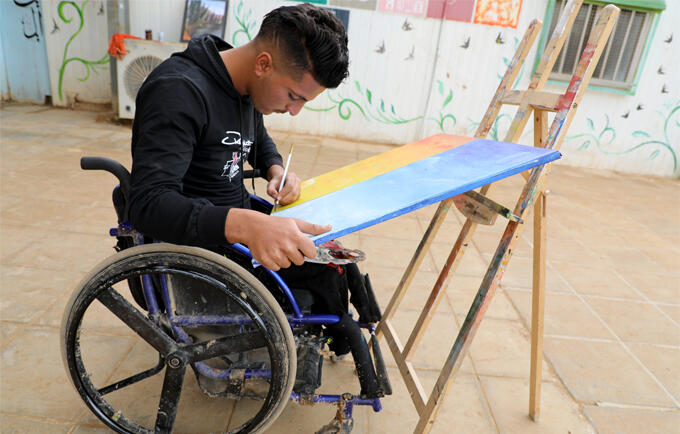Conflict, violence and disability collided to test Sami’s resolve. Instead of despairing, he took up paint and brush and became a symbol of enduring hope.
Before the Syria crisis erupted in 2013, Sami was a happy-go-lucky 10-year-old child who idolized football more than anything. Whenever he had the chance, he was inseparable from the pitch, playing for hours on end, giving his best to become more like his favorite “El Clásico” star.
Things took an unfortunate turn a few years later. On a hot summer day in Dara’a, amid the mounting violence in the country, Sami was out to play football with his friends in front of his house, when he heard a voice screaming from afar, “hide! Hide!”
As he reached for his ball, he saw it rolling down the street and ran after it, but everything around him quickly vanished. When he opened his eyes, his world was never the same again.
Sami woke up to a different reality; while he was able to feel his legs, moving and walking were not an option; he was powerless and too weak to stand. Too many thoughts were racing in his mind, but one thought took hold of his being: “will I ever be able to walk again?”
Before long, it seemed as though the whole had changed. The neighborhood in which he grew up was leveled to the ground. The airstrike had demolished everything; his home and the houses around it, and all of his memories. Judging by the damage, Sami had very little hope that any of his friends had survived. “I lost my legs, my friends and my house,” explains Sami, “but not only that — I also became a refugee. It felt like dying a slow, agonizing death.”
In 2014, Sami fled to Jordan for safe refuge. At first, it was a struggle; he was in shock as he adapted to the new surroundings; a challenge that was exacerbated by his physical disability. Soon after his arrival, a few volunteers introduced him to the youth spaces supported by UNFPA, where he was able to receive individual counseling and group support. He was also enrolled in a series of life skills and art courses, including calligraphy, painting, mosaic, and crafts.
At the center, Sami took an interest in painting; his love for colors manifested in beautiful drawings filled with messages of hope. He is happiest when he is around paint bottles and brushes, so he started frequenting the center and, over time, he cultivated a wide range of friendships that have offered much-needed support during this transition.
Expressing himself through artwork restored Sami’s faith in humanity; the feelings of loneliness and helplessness have long since left him. Today, he is a young and aspiring artist at 17, and his paintings are displayed in various exhibitions across Jordan. When asked about the crisis or how his life has changed since March 2011, he does not have to speak; every stroke of his brush speaks volumes.


